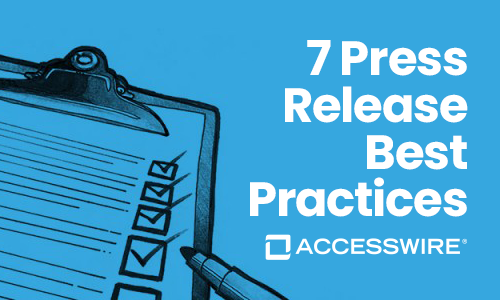A Guide to The Inverted Pyramid Press Release
What separates a good press release from a bad press release? It is clear, compelling, and direct language that conveys factual and valuable information. But, for a press release to be effective, people need to read it. That may seem obvious, but it’s more difficult to achieve than you might assume. Working with an effective press release distribution service might just be the perfect solution.
People’s attentions are scattered. So, how do you make your press release stand out? That’s where the inverted pyramid press release can be a valuable tool.
An inverted pyramid style of press release can cut through the noise by placing the essential information at the beginning of your press release. This guide will go over the inverted pyramid press release: what it is, why it is effective, and how to use it when creating your press release.
Why Is the Inverted Pyramid Used in Press Releases?
Studies show that the longer a news story is, the more readers it will lose. 100% read the headline. 70% read the first paragraph. 50% make it to the second. 30% get through the third. By the time you reach the fourth paragraph, only 10% of readers remain.1
That’s quite the war of attrition you’re fighting to get people to read what you’ve written.
But rather than be discouraged about people’s reading habits, we need to use this information to optimize our press releases. By putting the essential information first, we ensure that the highest number of readers will see it. So, what is the most relevant information?
- Who
- What
- Where
- When
- Why
- How
Known as the five Ws (and 1 H), these are the key details for any piece of content. By putting them at the beginning of a piece, you make sure the highest number of people get these key facts. There are also other benefits to the inverted pyramid style:
- Concision – So, how long should a press release be? Keep in mind that more and more people will drop off reading the longer you go, meaning your release should be concise in length. This press release format encourages you to be concise. This concision will also help improve your clarity as you present the information you are giving.
- Engagement – While we may lose readers the longer we write, the goal is still to keep them reading for the entire piece. By frontloading your press release with the most relevant information, you make people intrigued and encourage them to keep reading. Also take time to look to your press release analytics to determine what’s working and what’s not to help improve engagement.
- Better SEO – You may not immediately think of search engine optimization in a press release, but it is an important piece. By having quality SEO, you will expand the possible reach of your content. The inverted pyramid structure encourages using key phrases early in a way that is best for SEO. This can help your content across the board.
- Accessibility – One thing that may stop someone from reading an entire press release is a disability. ADHD or dyslexia can make reading large blocks of text a difficult task. By putting the most important info at the front of your piece, you make your press release more inclusive.
Structure of the Inverted Pyramid Press Release
Now that you can see some of the advantages of the inverted pyramid style of press release, you may be wondering how exactly one is constructed. You know the key information has to come first, but what else goes into making a successfully inverted pyramid press release? Let’s break it down.3
Headline
This is the part that 100% of readers will read so you better make it good. You want your press release headline to be short and to the point while conveying key information. You may not be able to include all of your Ws in a headline alone, but summing up your press release in a quick, engaging way will get more people to read on.
A couple of other points about the headline:
- Keywords – This is an opportunity to use keywords, and this isn’t about SEO padding. Keywords should signal what your press release is about, so putting them in a headline makes sense.
- Subheadlines – Especially for more complex content, a subheadline can be useful. Your headline will grab people’s attention, whereas the subheadline can give more relevant detail. This ensures some information will get through even to people who don’t make it to the first paragraph.
First Paragraph
This is where you need to focus on your who, what, where, when, why, and how. Immediately give your readers the most salient information. You can provide more details in the rest of the content, but even if people stop reading at the end of the first paragraph, they should have a good sense of what your press release is all about.
Another thing to keep in mind when constructing the first paragraph is that it will set the tone for the rest of your press release. If you’re clear and concise in the first paragraph, you set the expectation that the rest of your release will also be clear and concise, making it so that readers are more likely to stick with you.
Second Paragraph
This is where you can flesh things out a bit. You can provide more details and relevant facts. You can also get a bit more creative in your writing style. Think of this as a development paragraph.
If the first paragraph was just the facts, this is where you can show off a bit and focus on trying to create an emotional response to the information you are setting out. If someone has read this far, the way to keep them reading now is to engage them beyond a merely factual interest.
Third Paragraph
This is the place to add context and background to your press release. Include quotes from experts. Give supporting facts and statistics. You should try to encourage your readers to start thinking on their own and to form their own judgments.
Essentially, this section is where some extra work on your end can pay off and make the information you’re conveying more credible and convincing.
Fourth Paragraph
This is your conclusion. You’ll want to reiterate your main point and summarize what you’ve written. This is what you’re leaving the reader with, so you want to make sure you’re clear and that you help them process what they’ve just read. Some other things you may include:
- Additional quotations or facts
- Any relevant call-to-action
- Any final points you want to get across
Boilerplate
Sometimes folded into the fourth paragraph, and sometimes a paragraph of its own is boilerplate. This is where you provide corporate information and contact details.
It is also where you provide context for your qualifications and why you’re someone worth listening to. It’s also important to include any follow-up contact details in case any media representative wants to reach you.
Traps of the Inverted Pyramid
Have you ever watched a police procedural on television and felt like it was just ticking off boxes? It starts with the discovery of a body. Detectives start compiling suspects. The top suspect turns out to be innocent. There’s a twist where they find a new suspect. They find evidence that makes the new suspect confess.
Gets kind of boring, doesn’t it?
The same thing can happen in a press release. You can see how the inverted pyramid style can provide myriad benefits, but you still need to avoid the trap of creating something that reads like you’re just painting by numbers. Some tips to avoid this trap:
- Creativity – Good writing is still key. A press release template is a great starting point, but the best writers will elevate your material beyond boring press release writing and into something people will enjoy reading.
- Research – Press release writing can be a lot like how journalists write in that the best pieces will successfully argue for their own theses. By including supporting details and expert quotes, you create more engaging and more convincing material.
- Don’t let the tail wag the dog – The inverted pyramid is a tool for creating better press releases, it’s not the goal in and of itself. Let your content dictate your form, not the other way around. If you need to add a paragraph or change the form in some other way, that’s okay so long as real thought has been put into it and it’s the content that’s dictating your choice.
Improve Your Content with ACCESSWIRE
Using the inverted pyramid structure can help improve your content and get more people to read your press or media release. Another way to improve your reach is by working with ACCESSWIRE. We’re specialists with over 15 years of experience providing regional, national, and global news to thousands of clients around the world.
Our press release distribution services will maximize your reach without blowing up your budget. We provide you with distribution where it matters most, with no hidden fees. We know it can be hard to gain media coverage in front of the right target audience, but we can help. So if you have a press release you want to get out, we at ACCESSWIRE are ready to help.
Sources:
Newswire. How To Write A Press Release Inverted Pyramid.
Sales Loves Marketing. 4 Examples of the Inverted Pyramid Style of Writing.
Sales Loves Marketing. The Inverted Pyramid Style of Content Writing – A Simple and Effective Method to Writing.
Similar Blog Posts
PRODUCTS
ACCESSWIRE | All Rights Reserved




